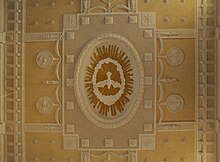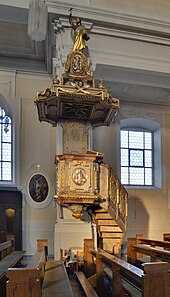St. Josef (Rheinfelden / Baden)
Sankt Josef is a Roman Catholic church in Rheinfelden (Baden) , which is under the patronage of Joseph the Worker . The patronage was chosen because the town, which was only a few years old, was dominated by industry with many workers. The church stands a little away from today's center of Rheinfelden, on the edge of the industrial area.
history
The Josefskirche replaced an emergency church built in 1899 from timber frame with around 330 seats in almost the same place, which was also consecrated to Saint Joseph, patron saint of carpenters. This first Catholic church in Rheinfeld was demolished after the construction of today's Josefskirche.
The foundation stone for the new building was laid on August 10, 1913, and the church was completed in 1915. The architect was Raimund Jeblinger , who was then senior construction inspector for the Archbishop's Building Authority in Freiburg . The Rheinfeld architect Ewald Steffen was in charge of the construction work; the local builder and contractor Albert Schröter carried out the construction work. When it was completed, the building was very simply furnished. In 1915 the church did not yet have an organ, no ceiling and Stations of the Cross, and no bells either. One of the reasons for this was the lack of metals essential for armaments caused by the First World War. The church was inaugurated in 1921, and a year later a ring made of four cast steel bells could be purchased.
The parishes of the Rheinfeld mother town Nollingen and St. Josef formed a common parish curatio from 1901 to 1916 . After the emergency church was inaugurated with the help of the Nollingen church choir, a year later a separate St. Josef church choir was founded, which still exists today.
Cracks have been visible in the church since the 1950s, and one day the representation of the Holy Spirit stuccoed as a dove fell from the ceiling of the nave. This damage stirred by strong subsidence in the ground here, which is a result of the salt brine extraction had formed of the neighboring chemical plants. Chemische Werke Hüls AG (today's Evonik Degussa ), as the successor to the causative company Griesheim-Elektron, reached an agreement with the mining authority on claims settlement . The repair costs amounted to three to four million German marks . As a result, the brine production in Rheinfelden in Baden was stopped, which calmed down the subsidence.
Since October 8, 2006, the parish of St. Josef together with St. Felix and Regula in the district of Nollingen and St. Gallus in the district of Warmbach has been part of the Rheinfelden pastoral care unit in the Wiesental dean's office . The pastor of Nollingen also became pastor of St. Josef and St. Gallus and heads the parish association.
description
Church building
The historicist style of the building is most likely to be attributed to late neoclassicism , although the characteristics are not uniform, the founding document even speaks of a baroque church and a later document of empire style . Also renaissance - and nouveau-like elements can be found. In the color scheme of the exterior plaster, cream, beige and medium brown tones are predominant.
The façades of the church are clearly structured vertically and horizontally. The three-part entrance hall in front of the nave, facing northwest and crowned by a gable, is decorated with pillars , pilasters and pilaster strips . The nave is closed by a mansard roof.
Southwest of the choir is a three-storey bell tower with a copper Welsch dome , in which bells made of steel now hang. The tower with a square floor plan has a clock on each side of the facade. Below the clock there are arched sound arcades with a surrounding metal parapet.
environment
The parsonage is located slightly offset behind the church building. In March 1997 a new parish center of the Catholic community was inaugurated east of the Josefskirche. In the area of a slightly recessed square to the left of the church, between the parsonage and the parish center, the sculptures “ Maria with the Child ” and “ Bremen Town Musicians ” are set up, both made of Jura limestone by Leonhard Eder. The emergency church once stood roughly in the area of this square.
Adolf Hermann (1910–1998), Catholic parish priest from 1949 to 1987 and made an honorary citizen of Rheinfelden on June 24, 1987, is remembered today by the path named after him along the south-western long side (tower side) of the church.
inner space
The interior of the nave with several aisles is decorated with garlands and other stucco ornaments. They come from the Rheinfeld master plasterer and plasterer Isidor Baggenstoss. The lower aisles are separated from the central nave by columns. Additional light enters the church through four round mansard windows. The central nave is one yoke longer than the side aisles and is closed off by a recessed round apse with four clover-leaf windows . The flat ceiling of the main nave is vaulted at its eastern and western ends. In terms of color, the room is mainly kept in light yellow, gray and whitish tones, supplemented by some gilding.
The church offers seating for 670 visitors in two 28 benches. Above the entrance portal is the column-supported organ gallery, on which a further 70 people can sit. Two balconies have been drawn into the choir at the sides.
Furnishing
On the walls, the 14 stations of the cross are shown in six framed paintings on copper sheet . They come from the painter Josef Mariano Kitschker (1879–1929), who also worked in the Bruchsal town church and St. Peter's Church . Since there was still free space on the side walls, the row of pictures of the Stations of the Cross on each side of the wall was supplemented by three representations at the back, which also deal with the cross in the broadest sense, for example the victory of the cross over martyrdom or the battle of the Milvian Bridge . A crusade motif contains an allusion to local history: the crusade preacher Bernhard von Clairvaux was also once in Rheinfelden on the left bank of the Rhine ; the silhouette of the medieval city can be seen in the picture on the right. The Munich artist Waldemar Kolmsperger the Younger (1881–1954) created additional pictures on the altars and vaults . The elliptical ceiling paintings of the large-format depictions of the Evangelists are also by Kolmsperger.
On the altar retable of the main altar in the choir, the namesake Joseph is shown in a large ellipse as he brings Jesus to the temple with Mary . Next to the picture, two wooden figures depict the prophet Simeon and the seer Hannah , the mother of the prophet Samuel .
On both sides of the main altar there is a side altar: the right one is consecrated to the Sacred Heart of Jesus , the left one to Mary. The celebration table and other pieces of equipment were created by the Rheinfeld artist Leonhard Eder from partially gold-plated cast aluminum , as an indication of a locally important industry. The altar shows religious symbols, e.g. B. Hands as a symbol for receiving communion and diverse, detailed scenes from everyday life such as machines, traffic, school lessons and others.
The pulpit is decorated with metal reliefs, the pulpit basket shows Jesus Christ on the left and Moses in front with the tablets of the law. When numbering the Ten Commandments on it, however, the maker made a mistake, because the Roman number IX for the 9th commandment was reversed to number XI (eleven).
As a typical neoclassical style element, numerous angel heads between festoon-like wrapped cloths stand out in room decorations.
There is a bronze tabernacle in the Lady Chapel . In the sacristy , among other things, a late Gothic crescent moon Madonna is kept, which was acquired from Freiburg in the early 1930s, as well as a monstrance by the Augsburg gold and silversmith Johann Haltwanger from the 18th century.
organ
The gallery organ of the Josefskirche above the main entrance was made in 1927 by the organ builders Gebrüder Späth from Ennetach . The instrument with three manuals , a pedal and 41 stops was rebuilt in 1985 by master organ builder Hartwig Späth from March while retaining the old case. The number of registers was increased to 44. 37 of the registers have been completely or partially reused from the old work. A comprehensive organ renovation is planned for 2013.
The organ consists of a total of 2976 pipes , 344 of which consist of wood, 482 are reed pipes . It is operated via a mechanical game mechanism with an electrical register with 64 combinations. The gaming table is free-standing.
The disposition of today's organ is shown below.
|
|
|
|
|||||||||||||||||||||||||||||||||||||||||||||||||||||||||||||||||||||||||||||||||||||||||||||||||
- Coupling : II / I, I / P, II / P
- Playing aids : 64 free combinations
Bells
The big bell bears the name of the church patron St. Joseph. The four bells were cast in 1922 by the Bochum Association for Cast Steel Manufacture. The name of the formerly smallest, 111 kg older bell from 1899 could not be determined. It comes from the Gebrüder Koch foundry in Freiburg and was already hanging in the broken-down emergency church; Since the end of the 20th century it has been hanging as a death knell in a small steel tower next to the chapel of the city cemetery.
| No. | Name / patron | Nominal | Casting year |
| 1 | Big bell / St. Joseph | b ° | 1922 |
| 2 | Ave Maria bell | d ′ | 1922 |
| 3 | St. Conrad | f ′ | 1922 |
| 4th | Saint Anna | G' | 1922 |
literature
- Catholic parish of St. Josef Rheinfelden / Baden (Ed.): 100 years of Catholic pastoral care St. Josef Rheinfelden / Baden. Rheinfelden / Baden 1999.
- Johannes Helm : Churches and chapels in Markgräflerland , Müllheim / Baden 1989, ISBN 3-921709-16-4 , pp. 258-259.
Web links
Individual evidence
- ↑ Steinegger: Heimatgeschichte Nollingen Rheinfelden and the surrounding area up to 1922 , 1935, p. 339
- ↑ "The Rheinfelder said they can do that too" , Badische Zeitung , June 12, 2010
- ^ Landesarchivdirektion Baden-Württemberg, Landkreis Lörrach (ed.): Der Landkreis Lörrach , Volume II (Kandern to Zell im Wiesental), Jan Thorbecke Verlag Sigmaringen 1994, ISBN 3-7995-1354-X , p. 264.
- ↑ a b Helm: Churches and chapels in Markgräflerland , p. 259
- ^ Badische Zeitung: Organ renovation costs 135,000 euros . May 12, 2013. Retrieved October 20, 2013.
Coordinates: 47 ° 33 ′ 40.6 ″ N , 7 ° 47 ′ 29.7 ″ E
z







